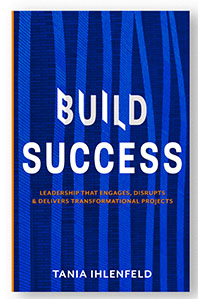
Innovating design leadership
What if large projects could adopt the advantages of smaller projects in terms of agile team size and structure, clear communication channels, a fearlessness to innovate and clear visibility of the issues? And what if small projects could bring in the discipline typically found in large-scale projects for an evidence-based design approach, establishing a sensible framework for managing risk, engaging with stakeholders, and advocating for a compelling vision?
We would see the opportunity to produce our built environments more efficiently and less labour intensively as a clear choice. We could focus on designing less sterile places that evoke more heart. Projects that are less of a drain on resources, and instead contribute to the health of our natural environment and the quality of our cities.
What if we could talk instead about how projects could not only NOT fail, but comprehensively succeed? In doing so, we could simultaneously raise the bar for design quality, environmental performance, and the endurance of our built environments.
So, what are some of the challenges faced by long-term projects in particular?
Typically, large-scale projects have been caught off guard by the regulatory and political environments. Add to this the rightfully heightened environmental considerations, as well as the greater demand for socially inclusive and healthier environments – and you have a dramatically changing context to work within.
You can’t retrofit environmental regulations into a mature design, nor should you want to.
Achieving net zero-carbon is one of the key challenges for new and existing buildings and infrastructure. These considerations affect investment options, operational performance requirements, budgets, programmes, risk and of course the overall quality of the outcome. Projects also need to push the boundaries of what is currently possible to implement – to remain relevant and operationally efficient when delivered many years after conception.
What about smaller, shorter timescale projects?
Smaller teams are easier to lead and manage. But they can still be derailed by poor communication, lack of resources or expertise, misaligned accountability, inadequate strategy or anticipation of risks, and insufficient understanding of stakeholder requirements. The team might also be less experienced or less focused as they juggle multiple projects without the necessary support systems in place to help them succeed.
Smaller projects are also becoming more complex as they increasingly need to comply with stricter regulatory and policy requirements.
A shorter timescale can also mean less time to sort out the mess!
Even when leadership is strong, success can come down to the chosen procurement strategy. For example, a contractor-led, design and build route means the design is very often unintentionally compromised because decisions are commercially driven. This is especially true if there hasn’t been sufficient strategic design undertaken in the early stages of the project, and if there isn’t a compelling vision and strong framework in place to secure the right outcome.
Getting projects off the ground is another challenge.
Considering that all projects, new or repurposed, are effectively promoting change - initiating them can be a significant undertaking. As we’re all too aware, people are usually averse to change whether in terms of the built environment or the changes associated with job roles or budgets required to support a project. Creating change in the physical environment as well as the marketplace can be a difficult sell.
Clients or stakeholders typically don’t want to be the first at doing something if it means that they need to take on all the risk.
Planning officers, with foresight, can be a project’s best friend. But they are not always supported by local policies and regulations or by a process that devotes sufficient time to understanding the proposal or to championing its improvement.
What if we could flip all of this on its head?
If large projects can adopt some of the advantages of smaller projects in terms of agility, creativity, and transparency, and small projects can adopt evidence-based design approach . . .
Step by step, it would be amazing to think of the inroads that could be made. I recognise that resources and budgets are tight, but this is exactly why searching for new ways of doing things is right for the challenges ahead. With enough people pulling in the same direction – change is possible.
I am keen to spark conversations for leaders within the built environment. I have written a book that is intended as a pragmatic blueprint to support courageous leaders in pursuit of high-quality project outcomes.
Our industry has some amazing opportunities and challenges ahead, that can use collective wisdom. You can book a call or check out my new book, plus learn more about our resources and services available for every budget with the tabs above and below.
Enabling your success!



